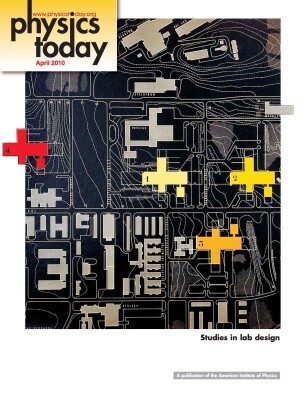Frontiers in spin-polarized tunneling
DOI: 10.1063/1.3397043
When Samuel Goudsmit and George Uhlenbeck proposed the concept of electron spin in 1925, who could have predicted that one day it would revolutionize information technology? In conventional electronics, charges are manipulated by electric fields while spins are ignored. Yet just a decade after Goudsmit and Uhlenbeck’s proposal, Nevill Mott set the stage for the development of spintronics, the control of the electrons’ spin degrees of freedom in devices, which has now emerged as one of the most dynamic fields in condensed-matter physics.
Specifically, Mott realized that spin could influence conduction. In ferromagnetic metals such as iron, nickel, and their alloys, neighboring electrons can lower their energy by aligning their spins. The effect is to split the band structure of the ferromagnet by an amount known as the exchange energy. This exchange splitting of the bands leads to more majority-spin electrons (spin-up, say) at the Fermi level than minority (spin-down) ones. The result is an imbalance in spin population among the charge carriers and, when an electric field is applied, a spin-polarized current.
The 1988 discovery of giant magnetoresistance (GMR) — the dramatic decrease in resistance that occurs when the relative magnetization alignment of two ferromagnetic layers separated by a nonmagnetic layer changes from antiparallel to parallel—marks one of the most successful developments in spintronics. For its discovery, Albert Fert (Université Paris-Sud) and Peter Grünberg (Jülich Research Center) were awarded the 2007 Nobel Prize in Physics (see Physics Today, December 2007, page 12
In this article we describe the evolution of a distinctly different phenomenon: spin-polarized tunneling. The physics behind GMR and SPT are similar only in that both involve ferromagnetic layers whose band structure exhibits a spin-dependent splitting. But in SPT the source of magnetoresistance is quantum mechanical tunneling through an insulating layer, not classical conduction. Today’s ultrafast read heads in high-density computer hard drives and the development of nonvolatile magnetic random access memory (MRAM), among many other devices, are direct results of research in SPT.
Spin polarization in tunneling experiments
In transition-metal ferromagnets, the conduction band is made up of electrons with sp- and d-orbital symmetries. The admixing of the sp and d electron wavefunctions gives the electrons their itinerant character. The spin polarization P is a measure of the spin-up and spin-down imbalance of the mobile electrons. In general, those with sp-wave angular momentum are positively spin polarized, and those with d-wave angular momentum are negatively spin polarized. The sp electrons are more likely to participate in tunneling than the more localized d electrons, which results in a net positive P.
The magnitude and sign of P, however, are also influenced by the interface between a ferromagnet and the insulating barrier. Researchers recognized spin tunneling’s sensitivity to the interface between an electrode and insulator as early as the 1970s. But it was not until the late 1990s, with the success of magnetic tunnel junctions, that the complexity in the roles of the electron orbitals emerged. For example, José María de Teresa and others measured a negative P in tunneling experiments that paired a cobalt electrode with a strontium titanate barrier, and used a lanthanum strontium manganese oxide as the spin detector. 18 That work revealed the dominance of d-band coupling across certain interfaces.
More recently, the importance of the symmetry-dependent barrier transmission became dramatically evident in magnetic tunnel junctions that sandwich a crystalline layer of magnesium oxide as a barrier between layers of crystalline iron or cobalt-iron alloy. In such crystalline junctions, a totally polarized band of spin-up electrons dominates the tunneling current. Indeed, the tunneling magnetoresistance—defined as 2P 1 P 2/(1 − P 1 P 2), where P 1 and P 2 are the spin polarizations of two ferromagnetic electrodes that form the junction—can exceed 600%. That enormous magnetoresistance makes them ideal building blocks for spintronic devices.
Interface magnetism
In 1960 Ivar Giaever published his classic measurements of the tunneling current between a superconductor and normal metal through a thin oxide barrier as the temperature fell below the superconducting critical point (see the article by Roland Schmitt in Physics Today, December 1961, page 38
That same year, Robert Meservey and Paul Tedrow (both of the Francis Bitter Magnet Laboratory at MIT) discovered SPT by replacing one of the superconductors with a ferromagnet to create a ferromagnet-insulator-superconductor sandwich. Meservey and Tedrow, along with Peter Fulde, a visiting scientist from Germany’s Frankfurt University, had been studying the high-magnetic-field properties of ultrathin films of superconducting aluminum when they serendipitously came upon the phenomenon. They noticed that at a temperature of 0.4 K and with a magnetic field of several tesla applied parallel to the Al film, the electron density of states splits into spin-up and spin-down components, well separated by the Zeeman energy (see figure 1). They immediately realized the importance of the result, particularly the possibility of using the spin-split superconducting Al film as a detector of the tunneling electrons’ spin orientation.
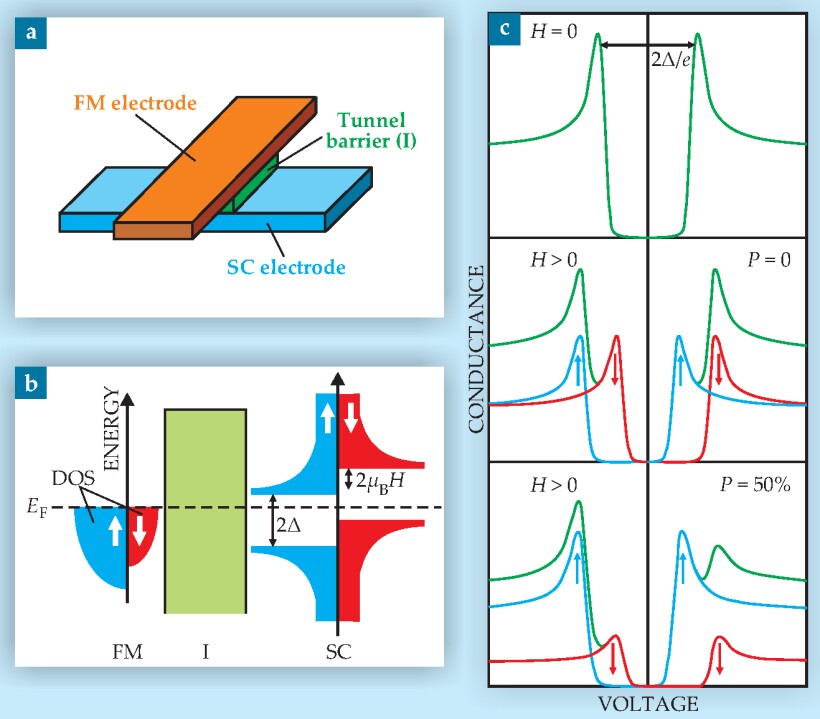
Figure 1. Spin-polarized tunneling. (a) A tunnel junction comprising a superconductor (SC) and a ferromagnet (FM), with a thin insulating barrier (I) between them. (b) The tunneling conductance is dominated by the electron density of states (DOS) at the two electrodes. An energy diagram illustrates the physics: On the left side of the junction, the FM contains a conduction band with unequal populations of spin-up (blue) and spin-down (red) electrons at the Fermi level E F that tunnel through the insulator (green). On the right is shown the 2Δ energy gap in the superconductor’s DOS and its Zeeman splitting 2µB H (µB is the Bohr magneton) in an applied magnetic field H. The tunneling spin polarization P is defined as the ratio of the relative number of up and down spin-polarized carriers (weighted by their mobility) to their total number. (c) The typical tunneling conductance (green) is shown as a function of bias voltage across the electrodes. At H = 0 (top), the conductance reveals only the SC energy gap. In an applied field, the Zeeman splitting lifts the degeneracy between the spin-up and spin-down states. If the counterelectrode is a normal metal (p = 0), the spin-up and spin-down peaks are of equal strength, as shown in the middle plot. In the case of a ferromagnetic counterelectrode (bottom), the nonzero spin polarization of tunneling electrons turns the conductance asymmetric.
(Adapted from ref. 1.)
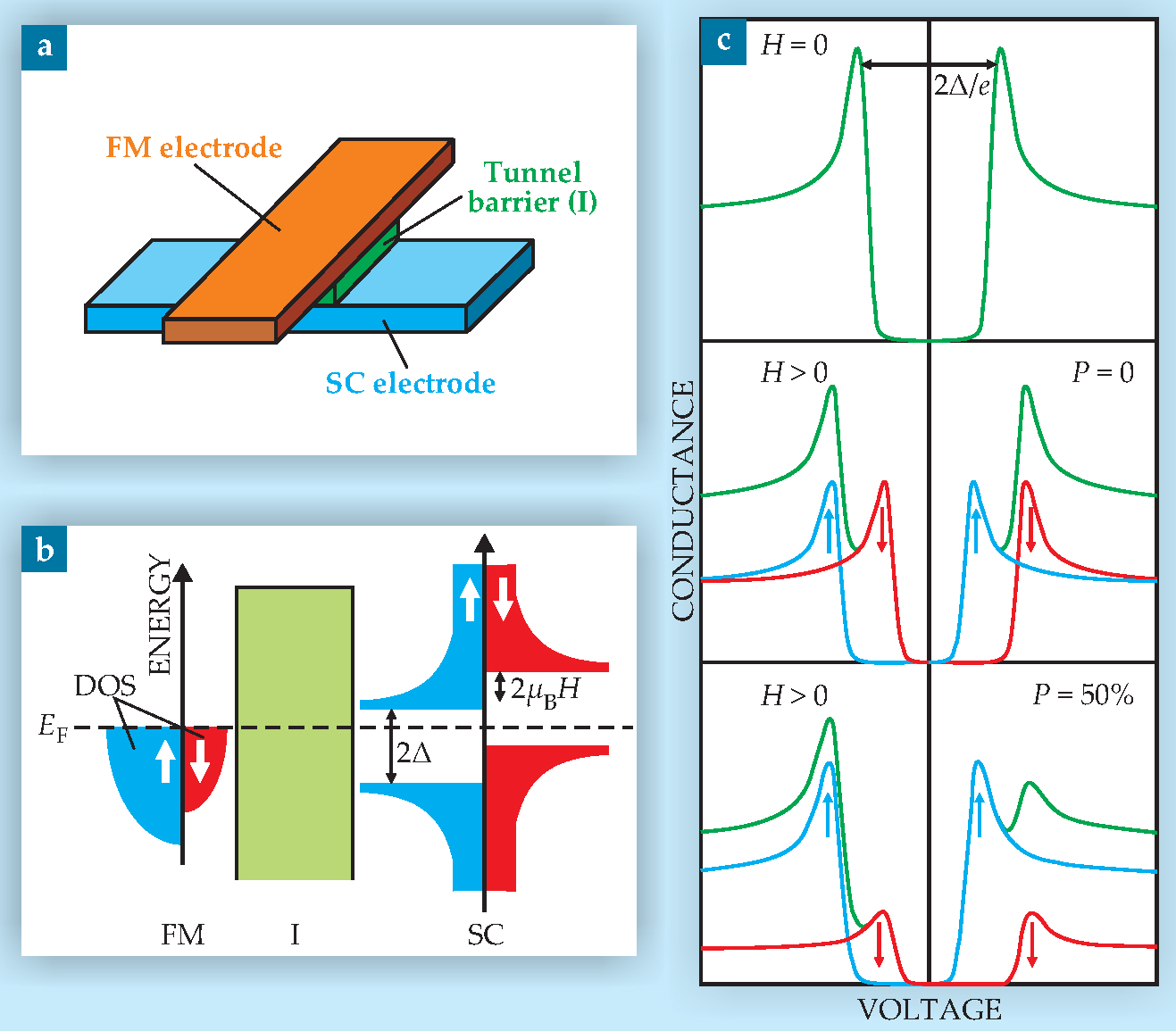
Several weeks later, Meservey and Tedrow succeeded in observing a spin-polarized current coming from the ferromagnet nickel. 1 Thus was born a new and powerful research field: a method to study interface magnetism using a superconductor. 2
Spin polarization P refers to the percentage of spin-up electrons near E F—or more precisely, the difference between the number of spin-up and spin-down electrons divided by their sum. Interestingly, skepticism lingered for years in the magnetism community over the observed positive sign of P, especially for nickel, whose density of states at the Fermi level suggested that negative spins should dominate. It turns out that one must account for the different mobilities of the hybridized sp- and d-orbital electrons during tunneling, not just the density of states, as Mary Beth Stearns (then at Ford Research Laboratories) argued in 1977. In recent years that understanding of P has become more complicated (see the
Meservey and Tedrow’s work marked the beginning of what would evolve 25 years later into a frenzied development of magnetic tunnel junctions (discussed below) and the current generation of computers whose hard-drive data densities are now approaching terabits/inch 2 . The key achievement was to demonstrate, in a series of experiments, that spin orientation was conserved in the tunneling process, one of the fundamental discoveries in condensed-matter physics. The SPT technique, moreover, enabled researchers to also probe the properties of superconductors in high magnetic fields. The onset of ferromagnetism in metals, defined as the existence of nonzero spin polarization, was shown to occur at submonolayer thickness in thin films such as iron and cobalt, whereas in thin nickel films it is strongly sensitive to interfacial band-interaction (hybridization) effects.
What made the discovery of SPT striking was that Al fortunately had properties so well suited for it to occur. Being a light metal, Al has negligible spin-orbit scattering that would mix the spin states. It also naturally grows ultrathin oxide films that are highly uniform and controllable and make nearly ideal tunnel barriers. In fact, aluminum itself can be deposited as an ultrathin conducting film, which enhances its superconducting properties: Its transition temperature is about 3 K (compared with 1.2 K in the bulk) and its critical magnetic field close to 5 T applied parallel to the film (compared with 10 mT in the bulk).
Magnetic tunnel junctions
Soon after the discovery of spin-polarized tunneling, Michel Jullière, then a graduate student at the National Institute of Applied Sciences in Rennes, France, began investigating the tunneling between two ferromagnetic films separated by an insulator. He predicted that for such a configuration, known as a magnetic tunnel junction, a large change in the tunneling conductance should occur when the magnetization alignment of the two ferromagnetic electrodes switches from parallel to antiparallel (see figure 2). The change, moreover, should be proportional to the product of their spin polarizations. 3
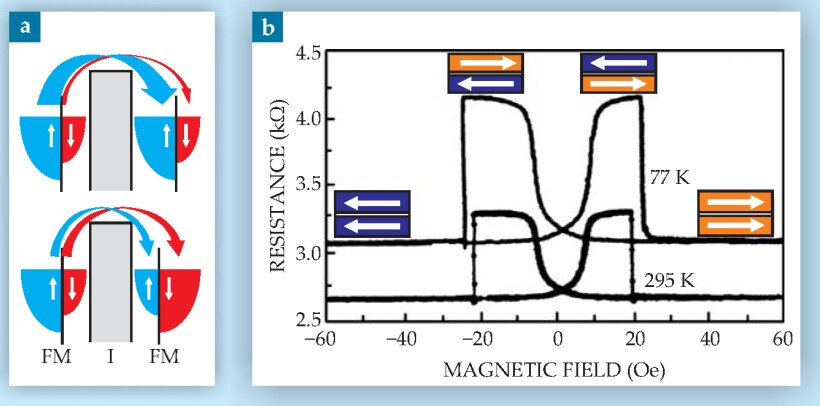
Figure 2. Magnetoresistance in magnetic tunnel junctions, structures normally composed of two ferromagnetic (FM) layers separated by a thin insulator (I). (a) A schematic of majority- and minority-electron energy bands of the two FM electrodes in parallel (top) and antiparallel (bottom) alignment. In parallel alignment, the conductance of each spin channel is roughly proportional to the product of the spin density of states (DOS) for the two electrodes. Spin-up electrons on the left easily tunnel into the spin-up band on the right; in the antiparallel case, the current is lower because either the initial or the final band has significantly lower DOS at the Fermi level E F. Magnetic tunnel junctions thus restrict the flow of electrons whose spins are antiparallel to those in the receiving electrode. (b) As a magnetic field applied to the junction increases, the junction’s resistance exhibits high and low states corresponding to the different spin alignments. At various values of the applied field, each set of arrows represent the majority spin configuration for the two FM electrodes.
(Adapted from ref. 6.)
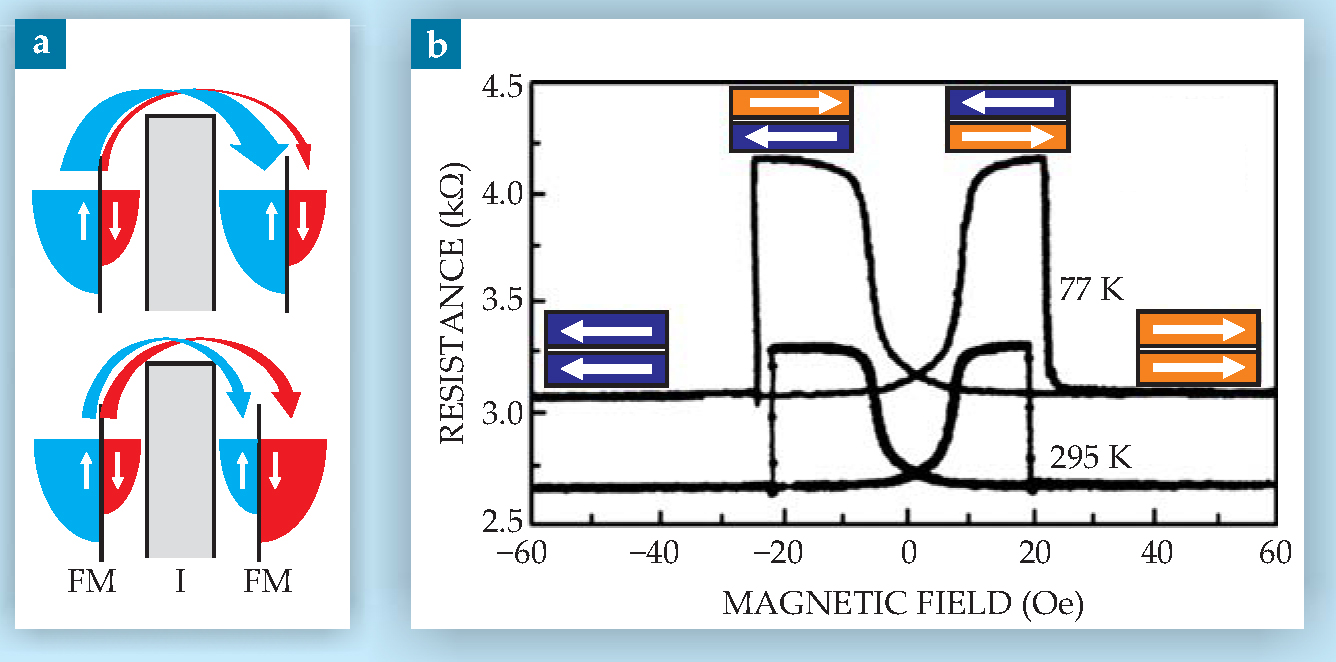
Jullière’s hypothesis, which formed part of his PhD thesis in 1975, was based on Tedrow and Meservey’s demonstration that spin is conserved during tunneling and on the fact that the tunneling current is, in general, proportional to the interfacial density of states of the two electrodes. In recent times it has come to be known as Jullière’s model of tunnel magnetoresistance. TMR refers to the change in resistance across the junction when the magnetization of the two electrodes changes from being parallel to antiparallel divided by the resistance when the electrodes’ magnetizations are parallel. That definition relates to spin polarization as discussed in the box. His reported TMR effect of about 14% at low temperature has been controversial, though. Progress was slow because creating a suitable tunneling barrier on top of a ferromagnetic film while still maintaining a clean interface was so challenging.
Finally, in 1995, one of us (Moodera) at MIT published experimental results showing the predicted TMR effect in a fully oxidized ultrathin Al 2O3 film barrier disposed between two ferromagnetic films. 4 Terunobu Miyazaki’s group at Tohoku University in Japan also reported some results the same year. 5
Ever since, the strong interface sensitivity, bias dependence, and other fascinating effects have been explored, 6 and the research field has expanded beyond expectation, with thousands of articles being published. TMR-based read-head sensors are now implemented in nearly every computer hard drive currently manufactured. And as part of the trend toward low-power devices, a strong effort is under way to develop TMR-based MRAM devices and logic circuits. The sensitivity of TMR-based magnetic sensors, also under development, is approaching that of superconducting quantum interference devices. Those sensors would be cheap, much simpler than SQUIDs (and not restricted to low-temperature operation), rugged, versatile, and enormously useful in, for example, medical applications, geological exploration, and defense surveillance.
Enter magnesium oxide
Magnetic tunnel junctions made using Al 2O3, one of the best ultrathin-film insulators around, can generate a TMR of up to 70-80%, high enough for most applications. Still, the ever-shrinking size of electronic devices and the need for increasingly powerful computers prompted researchers to search for better performers. In 2001 William Butler and his group, then at Oak Ridge National Laboratory, and Jorge Mathon and Alex Umerski, both at City University London, independently predicted 7 that a highly crystalline tunnel junction having magnesium oxide as its barrier should yield far higher TMR values—in excess of 1000%. Shinjo Yuasa’s group from Japan’s National Institute of Advanced Industrial Science and Technology and Stuart Parkin’s group at IBM Research-Almaden bore out the prediction experimentally. 8
When amorphous Al 2O3 acts as the barrier, the band symmetry of the electrodes has little effect. But in crystalline tunnel junctions such as Fe-MgO-Fe trilayers, proper orientation of the crystals at the interfaces dictates the entire effect. Matching the hybridized sp and d orbitals—together known as the Δ1 band—at the Fe-MgO interface gives rise to what’s known as symmetry-filtered (or coherent) tunneling. The symmetry-matched wavefunction with the smallest decay inside the barrier is that of the majority-spin Δ1 subband and overwhelmingly dominates the tunnel current. In epitaxially grown magnetic tunnel junctions, symmetry-filtered tunneling has led to giant TMR values.
The tunneling current measured from transition-metal ferromagnets separated by Al 2O3 barriers comes mostly from the itinerant sp electrons with P rarely higher than about 50%. Symmetry-filtered tunneling can push P higher.
8
Materials known as half-metallic ferromagnets, such as chromium dioxide and lanthanum strontium manganese oxide, have an energy gap at the Fermi level in one of the spin subbands. The conduction electrons in those materials are thus completely spin polarized (see the article by Warren Pickett and Moodera in Physics Today, May 2001, page 39
Spin filtering
Can the extreme sensitivity of tunneling current to barrier properties be exploited to produce a large spin polarization? All one would need is a tunneling barrier that is spin sensitive and selective enough to generate a fully spin-polarized current. Fortunately, very high values of P can be obtained by using a barrier whose tunneling probability depends on the spin of the electron. The ferromagnetic europium chalcogenides turn out to be ideal for the job.
Experimental work done in 1972 set the stage when Werner Heiland and colleagues demonstrated by field emission that tungsten tips covered in europium sulfide yield polarizations close to 90%. 9 The semiconductors EuS and EuO, paramagnets at room temperature, become well-behaved Heisenberg ferromagnets at low temperatures. In the ferromagnetic state, exchange splitting creates two conduction band edges as shown in figure 3. Spin-up electrons then experience a lower energy barrier than the one felt by spin-down electrons. When EuO or EuS sandwiched between two nonmagnetic metals becomes ferromagnetic, the result is a large decrease in tunnel-junction resistance to spin-up electrons. One can use that behavior to determine the exchange splitting in the ultrathin ferromagnetic films, even ones just a few monolayers thick—far from a trivial task otherwise.

Figure 3. Spin-filter effect. (a) When a ferromagnetic semiconductor such as europium oxide is cooled below its magnetic-ordering (or Curie) temperature T C, the conduction-band energy felt by spin-up and spin-down electrons splits into two levels separated by an energy 2ΔE Ex (about 0.5 eV here), a process known as exchange splitting. (b) In a metal-europium oxide-metal spin-filter tunnel junction, spin-up electrons experience a lower barrier height Φ than do spin-down electrons. When unpolarized electrons tunnel from a nonmagnetic metal through the EuO spin-filter barrier, the result is a highly spin-polarized current. (c) When the temperature drops below the Curie temperature, the resistance of the junction—in this case, aluminum-EuO-yttrium—also drops, and the spin polarization of its tunneling current approaches 100%. Measuring the junction’s current-voltage characteristics determines not only the exchange splitting in the magnetic layer, but also the extent of spin filtering.
(Adapted from ref. 17.)

Due to the exponential dependence of the tunneling probability on barrier height, the spin-up electrons dominate the tunneling current. The effect, known as spin filtering, can be substantial. In 1988 Moodera and colleagues at MIT used it to generate a large spin-polarized current (P roughly 90%) with a bias of less than a millivolt applied across a junction with a EuS barrier. EuSe, an antiferromagnetic semiconductor in zero magnetic field, generated an even more extreme P—close to 100%—under a moderate applied field. 10
In addition to generating those highly polarized tunneling currents, europium chalcogenide layers possess an internal field that splits the density of states in adjacent superconducting Al films. Theorist Pierre-Gilles de Gennes argued in the 1960s that a superconductor adjacent to a ferromagnetic insulator would give rise to an exchange interaction between charge carriers in a superconductor and ordered magnetic ions (such as Eu+2) in the ferromagnet. 11 Two decades later researchers in our MIT lab observed the enhanced Zeeman splitting (corresponding to more than a tesla) in a EuO/Al bilayer electrode. (The use of EuS as a barrier gives rise to an even more pronounced internal field of 4 T.) One can thus make spin-polarized tunneling measurements without actually subjecting the system to a large external field.
Magnetoresistance from spin filters
Spin filters can also be used to generate magnetoresistance in tunnel junctions. For example, in 2002 Patrick LeClair and colleagues at the Technical University of Eindhoven in the Netherlands sandwiched a EuS barrier between a ferromagnetic electrode (gadolinium) on one side and normal metal on the other. 12 By switching the magnetic configuration of the Gd relative to that of the spin filter from parallel to antiparallel, the Eindhoven team generated a TMR over 100%.
Five years later, Taro Nagahama and two of us (Santos and Moodera) found an unexpected bias dependence in such quasi-magnetic tunnel junctions. 13 The TMR increased when the bias voltage increased, contrary to what was usually observed in conventional magnetic tunnel junctions. The TMR peak at high bias results from the onset of Fowler-Nordheim tunneling—the tunneling of spin-up electrons from the fully polarized spin-up subband of the exchange-split barrier. The enhanced magnetoresistance effect opens the door for stable operation at far higher TMR values than can be achieved using conventional tunnel junctions.
Two spin filters placed between nonmagnetic metal electrodes can also generate a large TMR, a prediction made by Stanford University’s Daniel Worledge and Theodore Geballe in 2000 but not realized experimentally until this past year. 14 Figure 4 outlines the principle behind the double-barrier structure: By changing the relative magnetic orientation of the spin-filter layers, one can tune the tunneling probability from high to low, which generates a huge change in the resistance so that the spin-polarized current can be turned on and off like a valve. In figure 4’s example, one or two mono-layers of Al 2O3 serve to magnetically separate the two EuS barriers. The bias dependence then behaves similarly to what’s been observed in quasi-magnetic junctions.

Figure 4. (a) A double spin-filter tunnel junction comprises two spin filters (SF) that sit between nonmagnetic electrodes. An insulating spacer layer separates the SFs to magnetically decouple them. (b) The barrier height experienced by tunneling electrons depends on the mutual spin alignment of the two spin filters. When the two filters are aligned parallel, spin-up electrons can easily tunnel through the two barriers, and the junction is in its low-resistance state. In the spin filters’ antiparallel alignment, spin-up and spin-down electrons must both tunnel across a tall barrier, and the junction is in its high-resistance state. One can thus optimize the magnetoresistance by tuning the barrier transmission probability. (c) The first double spin-filter tunnel junctions were realized with two europium sulfide barriers. These curves of resistance R as a function of magnetic field H show the magnetoresistance for two different temperatures and were measured on a tunnel junction in which 1.5 nm of EuS is separated from 3 nm of EuS by 0.6 nm of aluminum oxide.
(Adapted from ref. 14.)

Materials quest
The spin-filtering and local-field effects exhibited by europium chalcogenides are beautiful to observe but occur mostly at liquid-helium temperatures. The magnetic-ordering temperature can be raised to some extent by proper doping, but that approach is limited. Lately, the limitation has prompted interest in perovskite- and spinel-structured ferrite and manganite compounds such as bismuth manganese oxide, cobalt iron oxide, and nickel iron oxide, which magnetically order at much higher temperatures.
When synthesized, however, those oxides suffer from an abundance of lattice defects. In some situations the defects can play to one’s advantage. For example, spin-filter efficiency is tunable by controllably inducing oxygen vacancies in CoFe2O4, and doping BiMnO3 with lanthanum helps to stabilize the compound without spoiling its properties.
Extensive materials research is needed before the ferrites can be considered device ready. Even so, La-doped BiMnO3, which exhibits ferroelectric properties, offers particular promise as a spin-filter material. Three years ago, Fert’s group exploited those properties to obtain more functionality in a spinfilter tunnel junction. 15 The oxide barrier is a multiferroic material: In addition to its two spin-filter states that are magnetically tunable, it has two ferroelectric states that can be manipulated electrically, as shown in figure 5. Thus, any of four distinct memory states can be obtained in a single device.
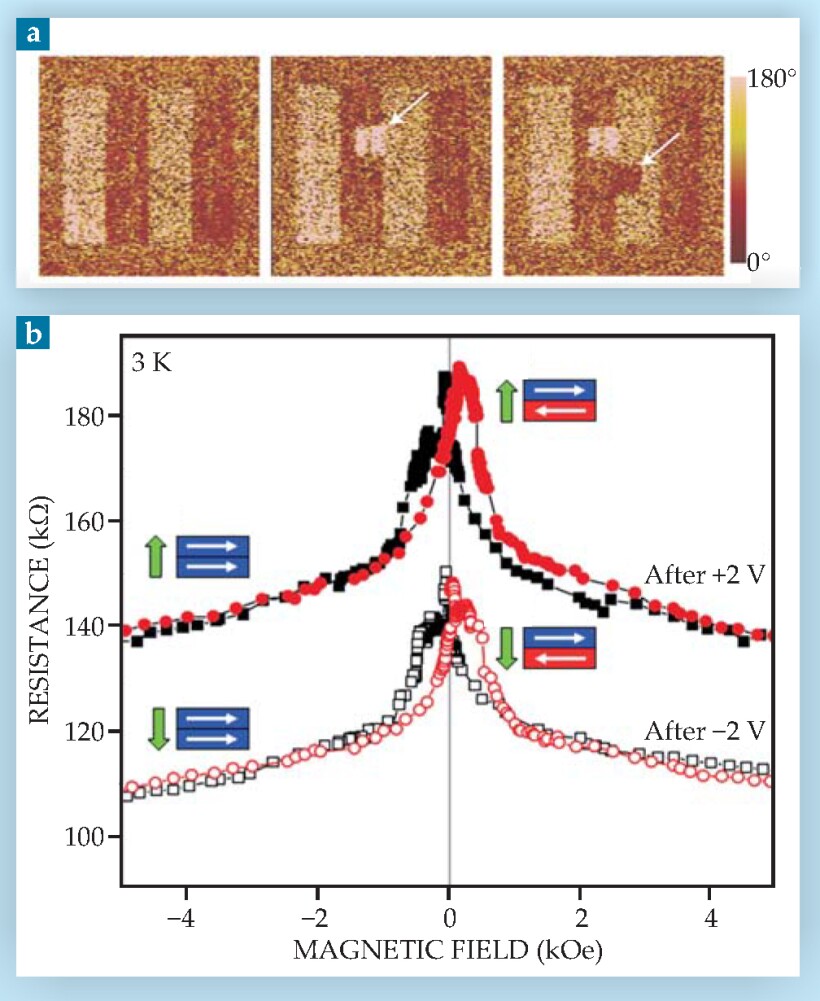
Figure 5. A four-state switch can be fashioned out of the multiferroic material lanthanum bismuth manganese oxide. (a) The bright and dark strips in these phase images from a piezoforce microscope were written by applying ±2 V on a 2-nm-thick LaBiMnO3 film. To demonstrate the switchable character, smaller, square-shaped areas (indicated with arrows) were rewritten by reversing the voltage polarity in subsequent images. (b) Magnetic tunnel junctions based on such a multi-ferroic barrier can exhibit four possible nonvolatile configurations: In addition to the high and low magneto-resistance states determined by antiparallel and parallel spin alignment, electroresistance states are produced by the two electric-polarization orientations indicated by the green arrows. The different configurations are illustrated in the two curves measured from a La1−x Sr x MnO3−La0.1Bi0.9MnO3–gold tunnel junction. The red and black curves are obtained from oppositely directed sweeps of the magnetic field.
(Adapted from ref. 15.)
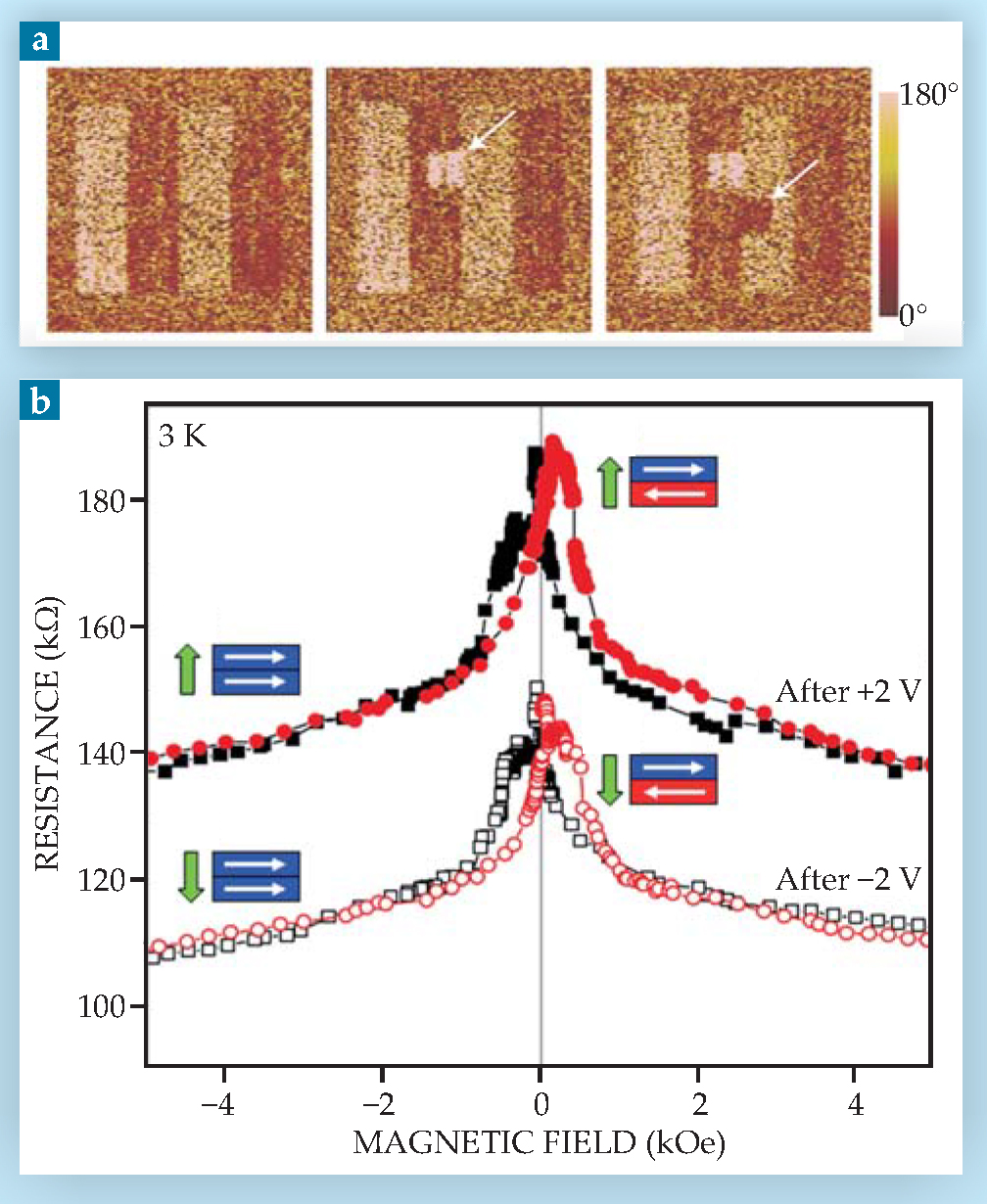
Beyond that example, spin-polarized and spin-filtering phenomena open exciting possibilities for fundamental and applied physics research. Tunnel junctions are, as we’ve said, ubiquitous in modern computer hard drives. But SPT has relevance for a variety of other spintronics applications as well, including universal memory and programmable gate arrays. Spin filtering, for its part, is likely to have an impact on multilevel memory and the electrical injection of spin into semiconductors. What’s more, spin filtering may offer an easy way to electrically read out the stored spin information in a qubit—an approach IBM’s David DiVincenzo discussed theoretically in 1999—and thus avoid the much more challenging magnetic readout schemes. 16 Not surprisingly, the more we learn about SPT, the more interesting it becomes.
The authors are grateful to Robert Meservey and Paul Tedrow for extensive discussions and to our research funding agencies—NSF, Office of Naval Research, the Defense Advanced Research Projects Agency, and the Korea Institute of Science and Technology-MIT joint program—for sustained support.
References
1. P. M. Tedrow, R. Meservey, Phys. Rev. Lett. 26, 192 (1971). https://doi.org/10.1103/PhysRevLett.26.192
2. R. Meservey, P. M. Tedrow, Phys. Rep. 238, 173 (1994). https://doi.org/10.1016/0370-1573(94)90105-8
3. M. Jullie`re, Phys. Lett. A 54, 225 (1975).
4. J. S. Moodera et al., Phys. Rev. Lett. 74, 3273 (1995). https://doi.org/10.1103/PhysRevLett.74.3273
5. T. Miyazaki, N. Tezuka, J. Magn. Magn. Mater. 139, L231 (1995). https://doi.org/10.1016/0304-8853(95)90001-2
6. J. M. Johnson, ed., Magnetoelectronics, Elsevier, Boston (2004), chap 3.
7. W. H. Butler et al., Phys. Rev. B 63, 054416 (2001); https://doi.org/10.1103/PhysRevB.63.054416
J. Mathon, A. Umerski, Phys. Rev. B 63, 220403–R (2001). https://doi.org/10.1103/PhysRevB.63.2204038. S. Yuasa et al., Nat. Mater. 3, 868 (2004); https://doi.org/10.1038/nmat1257
S. S.P. Parkin et al., Nat. Mater. 3, 862 (2004). https://doi.org/10.1038/nmat12569. N. Müller et al., Phys. Rev. Lett. 29, 1651 (1972). https://doi.org/10.1103/PhysRevLett.29.1651
10. X. Hao, J. S. Moodera, R. Meservey, Phys. Rev. Lett. 67, 1342 (1991); https://doi.org/10.1103/PhysRevLett.67.1342
J. S. Moodera, T. S. Santos, T. Nagahama, J. Phys.: Condens. Matter 19, 165202 (2007). https://doi.org/10.1088/0953-8984/19/16/16520211. P. G. de Gennes, Phys. Lett. 23, 10 (1966). https://doi.org/10.1016/0031-9163(66)90229-0
12. P. R. LeClair et al., Appl. Phys. Lett. 80, 625 (2002). https://doi.org/10.1063/1.1436284
13. T. Nagahama, T. S. Santos, J. S. Moodera, Phys. Rev. Lett. 99, 016602 (2007). https://doi.org/10.1103/PhysRevLett.99.016602
14. D. C. Worledge, T. H. Geballe, J. Appl. Phys. 88, 5277 (2000); https://doi.org/10.1063/1.1315619
G.-X. Miao, M. Müller, J. S. Moodera, Phys. Rev. Lett. 102, 076601 (2009). https://doi.org/10.1103/PhysRevLett.102.07660115. M. Gajek et al., Nat. Mater. 6, 296 (2007). https://doi.org/10.1038/nmat1860
16. D. P. DiVincenzo, J. Appl. Phys. 85, 4785 (1999). https://doi.org/10.1063/1.370481
17. T. S. Santos et al., Phys. Rev. Lett. 101, 147201 (2008). https://doi.org/10.1103/PhysRevLett.101.147201
18. J. M. de Teresa et al., Science 286, 507 (1999); https://doi.org/10.1126/science.286.5439.507
C. Tiusan et al., J. Phys.: Condens. Matter 19, 165201 (2007). https://doi.org/10.1088/0953-8984/19/16/165201
More about the Authors
Jagadeesh Moodera and Guo-Xing Miao are research scientists with the Francis Bitter Magnet Laboratory at Massachusetts Institute of Technology in Cambridge. Tiffany Santos is a postdoctoral researcher with the Center for Nanoscale Materials at Argonne National Laboratory in Argonne, Illinois.
Jagadeesh S. Moodera. 1 Massachusetts Institute of Technology, Cambridge, US .
Guo-Xing Miao. 2 Massachusetts Institute of Technology, Cambridge, US .
Tiffany S. Santos. 3 Argonne National Laboratory, Argonne, Illinois, US .
